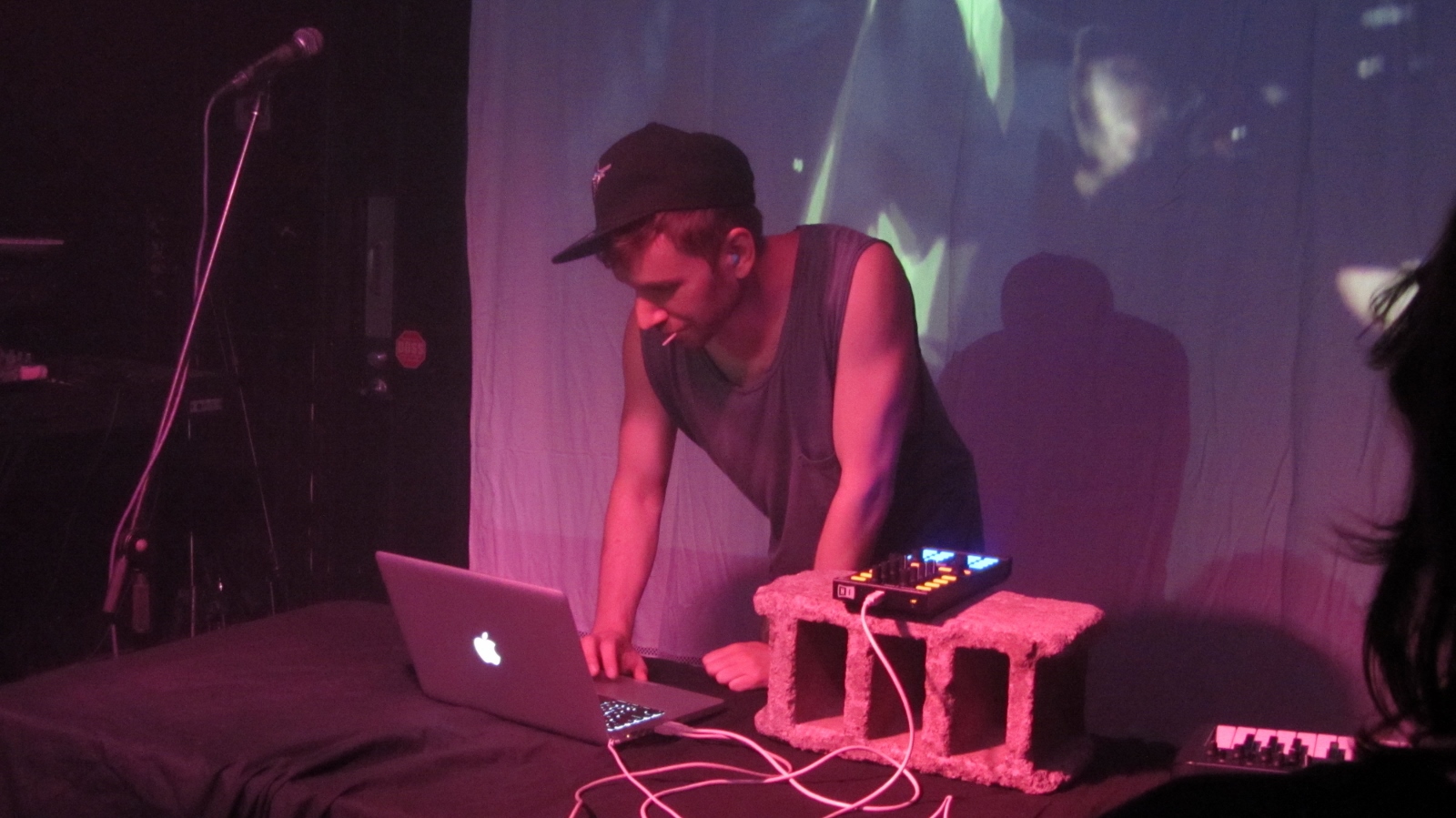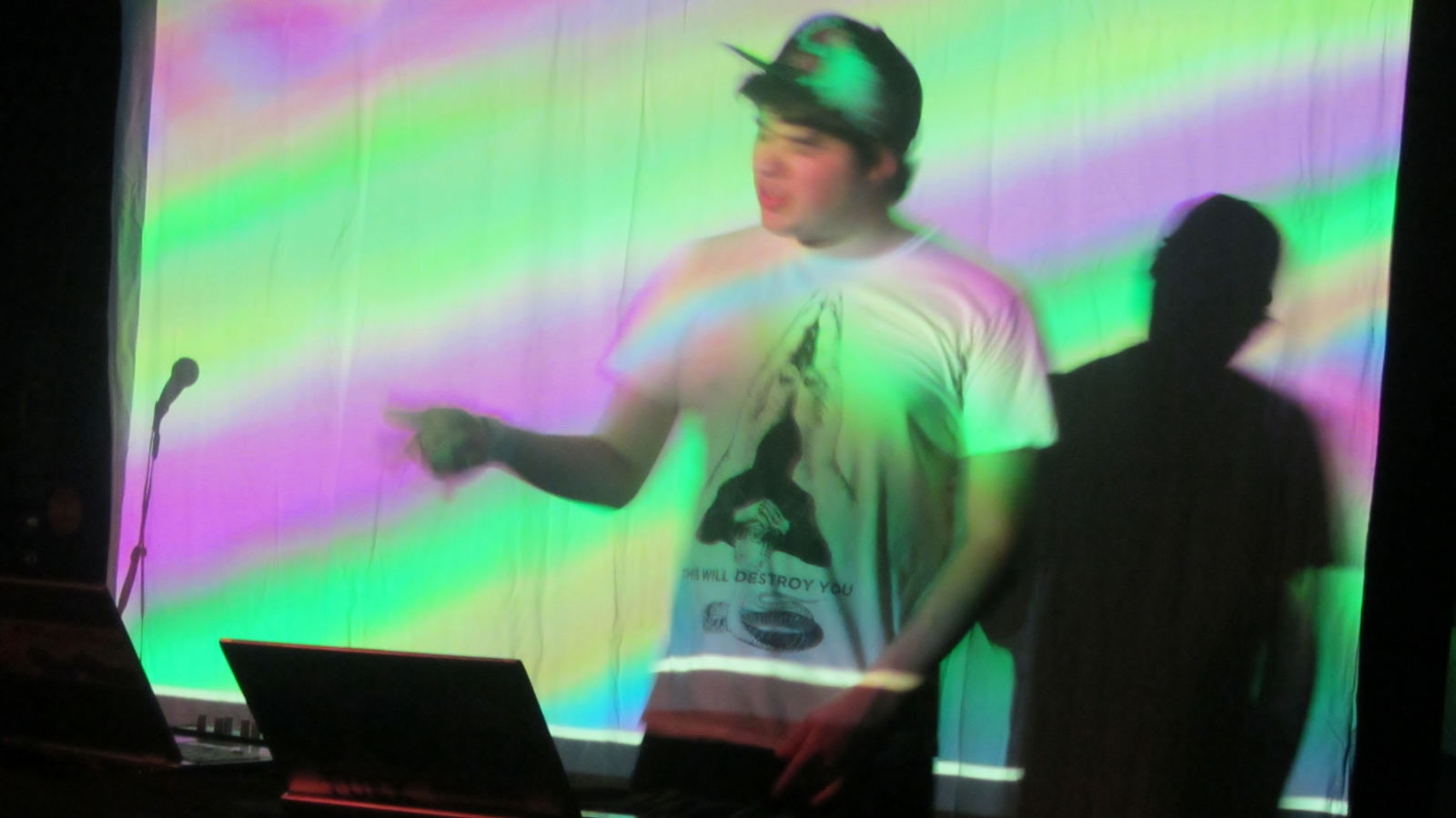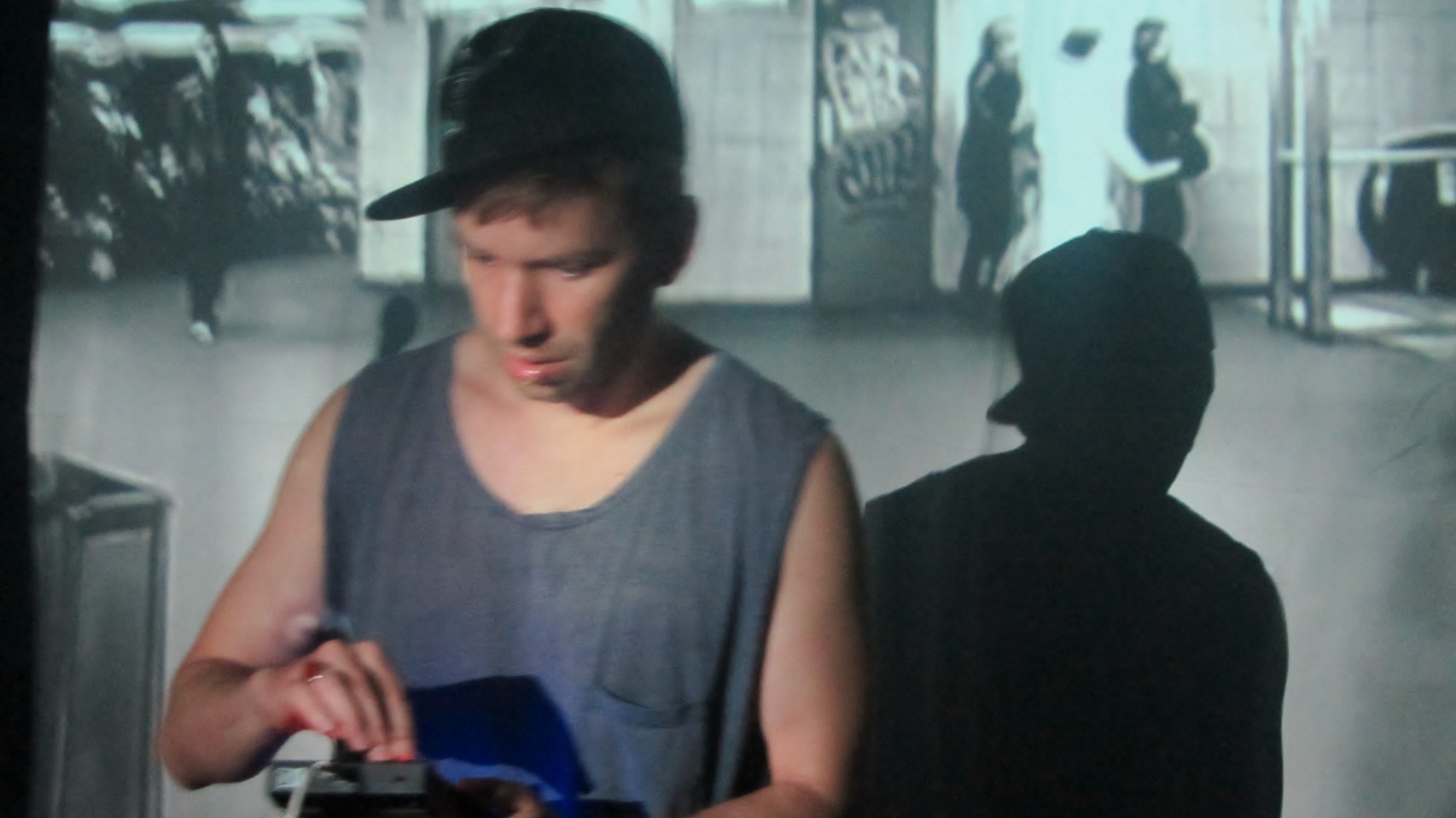Alright, we have a lot to talk about today, as last night we watched the mysterious performer oOoOO at Atlanta's 529. I came to the show with a lot of questions about oOoOO, including:
- Just how do you pronounce the name "oOoOO"?
- Is oOoOO a full band or just a single person?
- And what, exactly, is "witch house" and is it even a real thing? Does oOoOO still play in that style or did he ever?
And those are just for openers. So even though I had gone to 529 just the night before to see Takenobu, I went back again last night to get the answers to these and other questions, and not only did I get my answers, but I also wound up learning a lot, lot more.
There were three local, Atlanta bands on the bill before oOoOO. In fact, I suspect that the evening was originally intended to be an evening with just these three bands until the producer go the opportunity to book oOoOO, and tacked him onto the bill at the last minute. At least, I didn't even know that he was coming to town until about two weeks ago, and I'm pretty sure I would have noticed the name on the schedule if the show had been announced much earlier than that.
In any event, if not for oOoOO's name in the line-up, I doubt I would have gone last night - I hadn't heard of any of these performers before, and so had no motivation to drive down to East Atlanta Village to check them out. But as it turns out, the evening turned into an introduction to the Atlanta electronic music scene, a whole other movement in addition to the hip-hop, metal, and indie scenes I had mentioned yesterday, and one of which I was pretty much unaware of until last night.
By the time I arrived at around 10:00 pm (early by 529 standards), the first act, Hydrabadd, had already started. Perhaps. It was hard to tell. There was some sort of trippy electronic music being played over the house PA system at full concert volume, and a video screening behind the stage documenting various ethnic dance traditions (I saw some native Central American, some African, and some Persian dancers). But there was no performer on the stage, just a table full of laptops and other electronic gear, and only a handful of people in the club (I did note above that it was still early by 529 standards). I grabbed a beer and found a spot to watch the video - it actually was interesting in an arty sort of way.
Eventually, a young man in a baseball cap and a This Will Destroy You t-shirt, took the stage and began manipulating the music with his laptop, one of the two on the table. The video projection behind him continued although the documentary finished and various abstract and concrete images were now being projected. This apparently, was the start of the Hydrabadd performance, although I'm still not sure it the previous, non-manipulated music playing before was a part of his performance or not (or if it mattered - I was enjoying the show regardless if it was by the performer or by the house).
Although their Facebook page describes them as a duo, on stage, Hydrabadd appeared to be just one musician, an extremely capable electronic d.j., who played a seamless set that morphed from hooky electronic dance pop to hip-hop to chopped-and-screwed stop-time beats. The d.j. (I'll call him "Hydrabadd," although the name might refer to the band and not the performer) clearly loved the music, and half the fun was watching him gesticulate along with the beats he was creating on stage, backed by the video projections, which were start to look like the world's most psychedelic computer screen saver.
He played an extended set, nearly 45 minutes - long for the first of four acts. When he finished, he simply closed his laptop and left. Despite all of it's high technology, electronic music of this sort apparently doesn't require all that much hardware.
As the video was projecting clips from the film Naqoyqatsi in the background, the next act, No Eyes, prepared the stage for his set by draping a sheer fabric screen in front of the stage, so that he was performing in between two separate layers of video imagery. He then donned a Japanese Noh mask on the back of his head, letting the hood fall over his face, perhaps to screen his eyes from the bright light of the video projector, or perhaps just for the bizarre appearance. The effect was somewhat unsettling as one watched what appeared to be a twisted body intent on gazing at the video screen behind the performer on stage.
No Eyes set started with him singing through a heavily processed mic line, so that a single note was sustained and overdubbed so that it could harmonize with itself. This produced a dreamy, almost hypnotic sound, the electronic music equivalent to dream pop. At various times during his set, other vocalists came on stage and sang with him in much the same manner.
He played an extended set, nearly 45 minutes - long for the first of four acts. When he finished, he simply closed his laptop and left. Despite all of it's high technology, electronic music of this sort apparently doesn't require all that much hardware.
As the video was projecting clips from the film Naqoyqatsi in the background, the next act, No Eyes, prepared the stage for his set by draping a sheer fabric screen in front of the stage, so that he was performing in between two separate layers of video imagery. He then donned a Japanese Noh mask on the back of his head, letting the hood fall over his face, perhaps to screen his eyes from the bright light of the video projector, or perhaps just for the bizarre appearance. The effect was somewhat unsettling as one watched what appeared to be a twisted body intent on gazing at the video screen behind the performer on stage.
No Eyes set started with him singing through a heavily processed mic line, so that a single note was sustained and overdubbed so that it could harmonize with itself. This produced a dreamy, almost hypnotic sound, the electronic music equivalent to dream pop. At various times during his set, other vocalists came on stage and sang with him in much the same manner.
The Noh mask eventually came off and the music changed genres, eventually incorporating styles as diverse as hip-hop, techno, noise, and damn-if-I-know. Here's a pretty good sample of his sound(s):
No Eyes is apparently "comic-book fiend and bona-fide punk rocker" Seanny Georgie. There's an excellent and interesting interview with him over at the Urban Whim blog, which describes his music as "trans-techno shoegaze" (whatever that is). Georgie played a nearly hour-long set until the club's sound man finally gestured to him to wrap it up, and even then he attempted to perform an encore at the encouragement of the audience, but found to his dismay that his feed to the PA system had been cut off.
The table with laptops and other electronic equipment was finally cleared away for Twins' set, along with No Eyes' stage-front curtain. Despite the name, Twins is also a solo act, just like all the other bands that performed last night, including oOoOO (which answers one of my questions). In addition to playing more traditional keyboards rather than d.j.'ing from a laptop, Twins probably came closest to performing his music in the more traditional song structure, although the music and the songs were still clearly in the electronic music genre.
Matt Weiner of Twins comes to electronic music not from the techno/house traditions of Hydrabadd and No Eyes, but from the New Wave/No Wave traditions of bands like Joy Division and Echo & The Bunnymen. At times, especially when the strobe lights came on, I was reminded on the current band Trust. The video projections, which had ceaselessly played throughout the entire evening, both during and between all of the sets, continued throughout Twins' set, although I think Weiner would have preferred to have played in the darkness, illuminated only by the strobes (like Trust when I saw them at Holocene during MFNW 2012). He even asked for the lights to be dimmed and the house obligingly turned off the stage lights, but the real illumination came from the video projector, which by and large washed out the strobe effect.
In any even, Weiner played standing behind his keyboards, but once the samples were up and running he would take the microphone and wander the stage, occasionally venturing as far into the audience as his mic cord would allow (somebody buy this man a cordless microphone).
An answer to Question Number One, above, was provided at the end of Twins set when he informed the audience that "Ooo-Ooo-Ooo" was up next, but even he seemed tentative about pronouncing "oOoOO." Given the spooky cover of oOoOO's first EP, I thought it might be pronounced like the sounds of a Halloween ghost, one long, quavering "Ooooooooooooooo," but Weiner, perhaps thrown off by the quirky capitalizations, broke it into three separate syllables.

I've learned today from Pitchfork that it's simply pronounced "Oh."
So, at least that's answered. And following Twins set, as Christopher Dexter, wearing a Florida Marlins baseball cap at a cocky angle, finally got to set up his laptop and electronics at 1:00 am, I learned that like all of the previous acts, oOoOO is a one-man band.
So finally, Question Number Three - just what is it that oOoOO plays? What was immediately apparent as soon as the set began was that Dexter's music was played at a significantly slower pace than anyone on stage before. In fact, the 529 audience, which had by now filled the small venue, was quite loud and noisy throughout his first number, as if they didn't realize that the languid beats and samples weren't still part of the soundcheck, or perhaps just some sort of prelude before the beats dropped for the first song. But things never got any faster than that first composition, but did include the chopped-and-screwed sampling techniques of the earlier bands, although in a dramatically slowed-down fashion. The effect was almost narcotic, as if the music was being heard from another room by a codeine-influenced ear.
The projections behind the stage continued but now consisted of Dexter's own videos, black-and-white scenes of him roving large, mostly empty spaces, stalking old ladies in subways, and occasionally glaring menacingly at the camera. As the audience grew accustomed to the pace of his music, they began enthusiastically dancing, arm-pumping to the beats and frequently surging back and forth like one large amoebic mass. A high point of the evening was when everyone, including your humble narrator, were chanting along to I Need A Coach Bag, a song based on a sample from a Three Six Mafia song.
Seanny Georgie (No Eyes) stayed for oOoOO's set, and acted almost like a cheerleader near the front of the crowd, jumping up and down and waving his arms. It's nice to see that performing musicians can still be fans as well.
The whole evening was quite a revelation to me. While I go to a fair number of rock shows, I've been more-or-less oblivious to Atlanta's electronic music scene, and was more than impressed by the talent and diversity of the performers, the technological ingenuity of the music itself, and the artistry of the overall performance, particularly to whoever had put together the seamless video installation. The audience was clearly a different crowd than I see at most shows, both younger and more jockish, and with fewer hipsters. Many appeared to be Georgia Tech undergrads out to dance and rave it up a little on a Saturday night.
As far as an introduction to the current state of electronic music, I couldn't have asked for a better selection. Both Hydrabadd and No Eyes performed in a variety of styles, while Twins approached the music from a whole different perspective and tradition, and oOoOO pointed toward a next-level interpretation, cannibalizing his predecessors and doping up the product.
It was a fun and instructive evening.





No comments:
Post a Comment